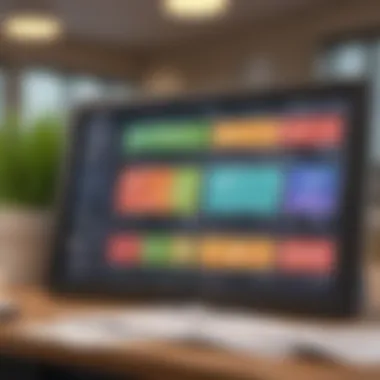The Essential Guide to Receipt Keeping Apps for Finance


Intro
In a world where digital receipts and online transactions have become an everyday norm, managing our financial records can be a daunting task. Keeping track of receipts is more than just maintaining a paper trail; it can significantly impact your budgeting, expense tracking, and ultimately, your financial health. Enter receipt keeping apps—these digital tools transform how individuals and businesses handle their paperwork.
The significance of these apps isn't merely in their utility; it extends to their ability to enhance financial clarity and save time. As the financial landscape continues to evolve, the relevance of effective organization cannot be overstated. This guide is designed to help you navigate the sea of options available, understand their features, and adopt best practices for receipt management. Whether you're a small business owner trying to streamline expenses or an individual wanting to keep your budget in check, there’s an app tailored for you. Let's dive in.
Prelims to Receipt Keeping Apps
In today's fast-paced financial world, the need for a clear and organized way to manage receipts cannot be overstated. Receipt keeping apps serve not merely as tools but as essential partners in navigating the complexities of personal finance. These digital resources simplify how individuals and businesses track expenses, making financial management not just practical but also efficient.
Understanding Receipt Management
Receipt management involves more than just shoving bits of paper into a drawer or snapping a photo with your phone. It encapsulates the entire process of categorizing, organizing, and ultimately analyzing financial transactions. Using a receipt keeping app can help streamline this workflow. When you upload a receipt, the app can instantly categorize the expense for you, saving you hours of tallying things up at tax time or when budgeting for the month ahead. This means fewer headaches during crunch time, allowing you to focus on other areas of your financial life.
Moreover, being able to track all receipts in a single platform means significant reductions in clutter and confusion. With many of these apps, you can even search for receipts by keyword or category, which brings up specific expenses in mere seconds. That's a far cry from rifling through a stack of crinkled paper, hoping you didn't toss that important lunch meeting receipt.
"Without a reliable way to manage receipts, many find themselves knee-deep in confusion come tax season."
Importance of Organized Finances
Keeping your finances organized is akin to putting your affairs in order. Think about it: when everything is structured, you not only take control of your spending but also gain insights into your financial habits. Financial organization fosters better decision-making. By utilizing a receipt keeping app, users can pinpoint where their money goes, making it easier to adjust budgets and prioritize essentials.
Regularly reviewing your organized receipts can also uncover spending patterns that may be causing financial strain. For instance, you may be amazed to realize how much you spend on takeout. If you're striving to become a wise investor or just seeking to build savings, this awareness can be crucial.
In summary, the convergence of effective receipt management and the importance of organized finances crafted in a user-friendly manner creates a strong foundation for achieving one’s financial goals.
Features of Effective Receipt Keeping Apps
In today's fast-paced world, managing personal finances can feel like a whirlwind. Effective receipt keeping apps can be lifesavers, providing benefits that streamline the entire process. Their significance cannot be overstated, as they enable users to maintain order amidst the chaos of receipts and financial records. Without the bells and whistles that make cumbersome tasks easier, many individuals would find themselves drowning in paperwork. Let's dissect what makes these applications effective, highlighting key features that enhance user experience and meet diverse financial needs.
User-Friendly Interface
When diving into an app, the first experience is often the interface. A clean, intuitive layout can make or break the user experience. Think of it as entering a room; if it's cluttered and chaotic, you might hesitate to step inside. Similarly, a user-friendly app ensures that users can navigate easily without scratching their heads or flipping through pages like an old paperback.
- Simple Navigation: Users should be able to find what they need without a treasure map. A well-organized menu structure helps.
- Visual Design: Aesthetics matter. Users are drawn to appealing designs that make the app inviting and less daunting.
- Accessibility Options: Inclusion of features for varied needs, making it easier for all users, regardless of tech-savviness.
The importance of a user-friendly interface cannot be underestimated; it can transform an initially frustrating chore into a breezy experience.
Automated Data Extraction
The sheer volume of data in receipts can feel overwhelming. Here, automated data extraction enters the picture like a trusty sidekick, doing the heavy lifting for you. This function leverages optical character recognition (OCR) technology, making it possible to scan and convert printed text into digital data.
- Time-Saving: Manual entry can be a drag, eating up valuable moments that could be spent elsewhere. With automated data extraction, users can zip through their records in moments.
- Accuracy: Mistakes during data entry are common. Automated systems minimize errors, ensuring that financial records are as precise as possible.
- Tax Reporting: Seamlessly gather all necessary info when tax season rolls around, lessening the stress that usually accompanies filing.
This feature is crucial for anyone wanting to keep their finances organized without the added burden of time-consuming entry.
Cloud Storage Integration
In an age where data is as valuable as gold, having reliable storage solutions is paramount. Cloud storage integration within receipt keeping apps allows users to save their data safely and retrieve it easily from anywhere.
- Data Security: Cloud solutions often provide robust security measures. Users can rest assured knowing their sensitive information isn’t stored on a shaky premise.
- Multi-device Access: Users can track expenses and access documents across multiple devices, be it a phone or laptop. This multi-device fluidity reflects modern life where people move from one gadget to another seamlessly.
- Backup Options: Having an accessible backup is like having insurance for financial peace of mind. Users can easily restore lost information without a hitch.
With cloud storage, users can focus less on the logistics of archiving and more on making sense of their financial journey.


Benefits of Using a Receipt Keeping App
In the world of personal finance, managing one's expenditures can often feel like herding cats. A receipt keeping app steps in as the trusty tool that transforms chaos into structure. Every transaction, no matter how small, has its tale to tell, and these apps help narrate it with ease.
Simplification of Expense Tracking
Expense tracking can be a daunting task, especially for those who prefer to avoid the intricacies of finance. That's where receipt keeping apps come in handy. With automated features, these tools allow users to scan receipts, automatically categorize expenses, and keep tabs on spending habits—all with minimal fuss.
Imagine this: You just had lunch at a local cafe and, instead of crumpling the receipt into your pocket, you snap a picture. Instantly, the app categorizes that lunch under "Dining Out" and updates your monthly food budget. It's like having your own personal accountant who works around the clock. With all expenses neatly organized, users can identify spending patterns and make informed decisions about where to cut back.
Having clarity on expenses helps avoid the dreaded end-of-month panic.
Tax Preparation Made Easier
When tax season rolls around, it's like being chased by a bear—stressful and daunting. However, a receipt keeping app can make tax preparation feel less like an ordeal. By cataloging every purchase throughout the year, the app provides a comprehensive record of deductible expenses. When it comes time to file taxes, instead of scrambling to find forms and receipts, users can simply export all necessary data from the app.
Furthermore, many apps allow users to input mileage for business-related travel, linking this information directly to their tax documentation. This functionality can save hours of back-and-forth, not just for the individual, but for their accountant as well.
"An organized record can mean the difference between a tax refund and a hefty tax bill."
Enhanced Budgeting Capabilities
Budgeting is crucial for financial health, and keeping track of receipts is one strategy to ensure things stay on track. Receipt keeping apps not only track spending but also promote proactive financial planning. Users can set budgets for various categories—like groceries or entertainment—and receive notifications when approaching these limits.
Moreover, these apps often provide insightful analytics, showing trends in spending. For instance, if one discovers that they're consistently overspending on coffee or dining out, it becomes easier to adjust either the budget or the habits themselves.
By incorporating these tools into daily practices, users can empower themselves with better financial visibility and control.
How to Choose the Right Receipt Keeping App
Selecting the ideal receipt keeping app can feel like searching for a needle in a haystack, especially with so many options out there. The right app not only saves you time but also makes managing your finances that much smoother. It’s crucial to take a moment and evaluate what you truly need from these apps and how they align with your goals for financial organization. A well-considered decision can lead to improved efficiency in tracking expenses and maintaining documentation.
Assessing Personal Needs
The first step revolves around understanding your personal needs. Consider the nature of your expenses. If you’re an entrepreneur juggling multiple expenses, a comprehensive app that offers features like categorization may be beneficial. Alternatively, a student might not require as many frills, just something simple to keep track of school-related purchases.
Questions to ponder include:
- Frequency of Use: Will you be updating your receipts daily, or just on occasion?
- Types of Expenses: Do you often have business receipts, personal expenses, or both?
- Reporting Requirements: Is there a need for detailed reports for tax purposes?
When you have clarity on your basic needs, the selection process will be less daunting.
Feature Comparison
Next up, take a close look at the features each app offers. Every app has its unique set of capabilities that may suit users differently. Here’s a snapshot of features you might want to look out for:
- Automated Data Entry: Some apps utilize OCR (Optical Character Recognition) technology for quick receipt capture.
- Expense Categorization: Helps in organizing expenses into groups, making it easier during tax season.
- Export Options: This feature is crucial if you need to share data with your financial advisor or transfer it to accounting software.
- Integration with Banks: For those who prefer an automatic experience, apps that link directly to your bank and credit card statements are beneficial.
Keeping a checklist of desired features helps streamline the comparison, allowing you to find the best fit.
Price Considerations
Finally, price matters significantly in your decision. While there are free options available, they often come with limitations, such as the number of receipts you can upload or certain features locked behind a paywall. Paid apps might range from a modest monthly fee to a more substantial annual subscription.
Consider the following when weighing price:


- Monthly vs. Annual Pricing: Sometimes, paying yearly can save you a few bucks. Look for any discounts.
- Trial Periods: Many apps offer trial periods—take advantage of these to see if the app meets your needs before committing.
- Long-term Value: Reflect on the cost versus the potential savings and efficiency gained in your financial management. If the app helps you save or gain back more time, then the investment may be worthwhile.
In your quest for the right receipt keeping app, it’s essential to thoughtfully assess your needs, compare features, and consider pricing. Each app might be icing on the cake in its own right, but only the right app will serve your financial recipe.
Top Receipt Keeping Apps on the Market
When one delves into the world of personal finance management, receipt keeping apps emerge as essential tools. These applications simplify the often daunting task of tracking spending, managing budgets, and organizing important documents. A well-chosen app can streamline your financial processes, making it easier to keep your finances in check while saving a significant amount of time.
In this section, we will highlight the most relevant apps currently on the market. Moreover, understanding how different apps measure up against each other will aid your decision-making process.
Overview of Popular Apps
There are numerous receipt keeping apps available, each offering a unique set of features and benefits. Some highlight functionalities like machine learning for accurate data extraction, while others prioritize user-friendly designs. Here are some of the most noteworthy options available:
- Expensify: This app is particularly favored among business users. With the ability to scan receipts and create expense reports seamlessly, it helps businesses maintain accurate records. Expensify also features mileage tracking and automatic syncing with credit cards.
- Shoeboxed: Shoeboxed excels in streamlining receipt management. Users can mail in physical receipts, and the company will handle the digitization process. This feature simplifies the busy lives of entrepreneurs and busy professionals.
- Receipts by Wave: For those who operate small businesses, Wave offers invoicing alongside receipt tracking. Users can upload photos of receipts, which Wave organizes efficiently. It serves as a one-stop-shop for managing business finances.
- Receipt Bank: This powerful tool is designed specifically for accountants and financial advisors. It allows them to integrate client receipts directly into their financial systems, significantly reducing manual data entry.
Each of these apps focuses on providing a specific solution, catering to diverse needs and preferences. The key is figuring out which of these aligns best with your unique circumstances.
Comparative Analysis
Comparing these apps is where insights can truly shine. Each app has its own merits and drawbacks. Considerations such as cost, ease of use, available features, and data security all factor into choosing the right app for your expenses.
Key Comparison Points:
- Cost: Not all apps are created equal regarding price. Some charge monthly, while others have a one-time fee or even free versions with limited features. For instance, Expensify’s pricing is based on usage, making it suitable for those who might have fluctuating needs.
- User Experience: A clean interface can make a world of difference. The simpler it is to navigate an app, the more likely users are to consistently log their expenses. Shoeboxed is often praised for its intuitive layout.
- Integration Capabilities: Does the app sync with your bank or accounting software? The answer can determine how smoothly your finances flow. Receipt Bank stands out for its ability to integrate seamlessly with various financial software.
- Security Measures: One cannot overlook the importance of data privacy. Understanding how each app safeguards user information is crucial, especially for businesses. Most reputable apps like Wave employ robust encryption methods, providing peace of mind to users.
Ultimately, the choice of app hinges on what you value most. By taking stock of your individual and business needs, you can make an informed decision that suits your financial landscape. To put it in straightforward terms, it’s about finding the right tool for the job.
Best Practices for Using Receipt Keeping Apps
Using receipt keeping apps can significantly streamline how you manage your finances. However, just having an app is not enough; it’s how you use it that can make a world of difference. Adhering to best practices not only ensures that your financial documentation is organized, but also enhances the overall usability of the app, allowing it to serve you well. Below are some crucial elements to consider when utilizing these tools.
Regular Updates and Maintenance
Regular updates and maintenance of your receipt keeping app are essential for ensuring it runs without a hitch. Many users underestimate the importance of this task, only to encounter bugs or feature limitations down the road. Keeping your app updated will often provide new features and security enhancements. Check for updates at least once a month, or enable automatic updates if the app provides that functionality.
Beyond just the app itself, it’s also important to keep your mobile device updated. System updates can affect how apps run, sometimes improving performance or fixing issues that may prevent you from accessing your receipts efficiently.
Backing Up Data
Imagine just for a moment: you’ve spent hours meticulously sorting receipts and inputting data, only to lose it all due to an unexpected app crash or a lost device. This is where backing up data makes its entry. Many receipt keeping apps offer cloud backup options, enabling you to save your valuable information online. By utilizing features like this, you ensure that your records are safe and accessible from multiple devices.
You may also want to consider exporting your data periodically to a compatible format, like CSV or PDF, which can be useful for creating independent backups. It’s one of those simple steps that pays dividends when you need to recover important financial documents without a hitch.
Utilizing App Features to the Fullest
Every receipt keeping app comes packed with features meant to ease your task of financial management. However, many users only scratch the surface. Take the time to explore capabilities such as:
- Receipt Scanning: Most apps allow you to scan physical receipts, converting them into digital copies. Make use of this feature to cut down on paper clutter.
- Categorization Tools: Many apps offer predefined categories you can use— take advantage of them. This will simplify reports and ensure you track spending in a meaningful way.
- Expense Reports: Some apps can generate summary reports based on your data. Understanding your spending patterns can help with budgeting and future planning.
"Taking the time to learn the ins and outs of your app can transform your financial organization from chaotic to seamless."
Challenges and Limitations of Receipt Keeping Apps


In the journey of managing personal finances, receipt keeping apps can be a game changer. However, they don’t come without their share of bumps along the road. Grasping these challenges is essential for users who wish to make the most of their financial management tools. Recognizing these limitations helps in setting realistic expectations and creating effective strategies for overcoming them.
Technical Issues
Every once in a while, users might find themselves wrestling with the technology behind these apps. A common hiccup involves the misreading of receipt data. Depending on the app’s algorithm, scanned receipts can sometimes turn into a jumbled mess of numbers and letters, making it frustrating to ensure accuracy. Many users have experienced this with various platforms, such as Expensify or Shoeboxed, where an essential expense is recorded incorrectly, leading to further complications when it comes time for expense tracking or tax preparation.
Additionally, apps can be prone to crashes or bugs. These glitches usually strike right when users are trying to access important financial records. Regular updates might temporarily fix problems but can also introduce new ones. This creates a cycle of minor inconveniences that can sour the overall user experience. For those in the middle of a busy work week, facing such interruptions can be more than just a hassle.
Data Privacy Concerns
While using a receipt keeping app, one might want to ask a critical question: "Is my data safe?" This is where privacy concerns come into the spotlight. Users often upload sensitive information, such as credit card numbers, personal addresses, or business transactions. When you hand over your details to an app, you’re banking on their commitment to security. But not all apps come with robust measures to protect your information.
For instance, data breaches can occur if the app's security protocols aren’t ironclad. There have been cases where unsuspecting users learned that their financial data had been compromised, leading to identity theft or financial loss. Such news can overshadow the advantages of using these apps and create an air of distrust. As a result, potential users might hesitate, wondering if the convenience of digital receipt management is worth risking their financial security.
"In the age of digital transactions, safeguarding your personal information is paramount. Users must do their due diligence before choosing an app to ensure it has solid security measures in place."
Future Trends in Receipt Keeping Technology
As technology marches on, so too do the methods we employ to manage our financial documentation. The integration of advanced technologies such as artificial intelligence and improvements in cloud efficiency will significantly influence the evolution of receipt keeping apps. With the stakes being high in the realm of personal finance, these innovations stand to streamline processes, enhance user experience, and bolster data security. Beneath the buzzwords, there are real benefits that can dramatically shape how individuals and businesses manage their finances.
Artificial Intelligence Integration
Artificial intelligence is not just a shiny trend; it’s becoming a cornerstone in many sectors, including receipt management. The incorporation of AI in these apps offers a transcendent level of automation. Imagine snapping a picture of your receipt and having the app automatically extract pertinent information such as the date, amount, and vendor with minimal user intervention. This boom in efficiency isn’t just for show; it has genuine implications for how users handle their records.
A few specific advantages stand out:
- Greater Accuracy: AI algorithms can learn over time, improving the precision of data extraction. This means fewer errors and a more reliable record-keeping process.
- Time Savings: With automated data entry, time spent inputting transaction details is slashed, allowing users to focus on higher-level financial decisions.
- Personalized Recommendations: AI can analyze financial habits and offer tailored budgeting strategies, nudging users towards smarter spending.
By targeting a more precise and automated system, not only do these apps cater to the needs of individual users, but they also provide valuable insights that can shine a light on spending habits and areas for improvement.
Increased Cloud Efficiency
As the world grows ever more interconnected, cloud technology becomes essential. More and more receipt keeping apps are embracing cloud-based storage solutions. This trend spells freedom from the clutter of paper receipts and the risk of losing critical documents. Increased cloud efficiency comes with several benefits that clarify its pertinence in today’s financial landscape:
- Accessibility Anywhere: Users can access their receipts from any device with internet access, which is a significant boon for those who often travel or manage finances on the go.
- Collaboration Capabilities: For entrepreneurs or professionals working on joint projects, being able to share and collaborate on expense reports in real-time can enhance productivity.
- Scalability: As businesses grow and accumulate more transactions, cloud storage adapts, ensuring there is always space for new data.
In a nutshell, leveraging cloud technology mitigates risks associated with loss or damage of physical documents. It supports a leaner, more efficient system of organization. With both AI and cloud efficiency shaping the future of receipt management, the landscape is looking brighter for anyone looking to keep their finances in check.
"The future is already here – it's just not evenly distributed."
— William Gibson
The End
In wrapping up our discussion on the significance of receipt keeping apps, it's clear that these tools are not just convenient but essential in the ever-evolving landscape of personal finance. Today, managing expenses is more than just keeping a few scraps of paper in a drawer; it requires a systematic approach that these apps facilitate brilliantly.
Summarizing Key Points
To sum it up, we explored key functionalities of receipt keeping apps, such as their user-friendly interfaces, automated data extraction abilities, and the seamless integration of cloud storage. By simplifying the process of tracking expenses, these applications help users gain a clearer view of their finances. Furthermore, we discussed how such tools play a pivotal role in tax preparation, enabling users to access organized records efficiently when needed. The comparative analysis of various apps also shed light on their strengths and weaknesses, arming users with the knowledge necessary for selecting the right one for their unique needs.
One cannot overlook the potential drawbacks, such as technical hitches and privacy concerns. However, armed with best practices, users can mitigate these challenges effectively. Overall, this narrative not only emphasizes the importance of receipt keeping apps but also highlights the transformative potential of technology in simplifying financial management.
Encouraging Adoption of Receipt Apps
Given the multitude of advantages to using receipt keeping apps, encouraging their adoption cannot be overstated. In an age where digital records are increasingly favored over paper, these applications help streamline the often convoluted process of financial tracking. For investors, financial advisors, analysts, and entrepreneurs alike, the ease of use and efficiency provided by these apps is a game-changer.
The flexibility of these tools empowers users to take charge of their financial health. They no longer have to grapple with an avalanche of receipts come tax season or scramble to piece together their spending habits at the end of the month. Instead, consistent use can lead to informed financial decisions. Encouraging a proactive approach to finances positions individuals not just for reactive management but for strategic financial planning.
As we adopt these modern tools, it’s crucial to emphasize that intent matters as much as the method. These apps require engagement and regular use; a mere download won't cut it. Being diligent in updating and checking the data ensures users harness the full potential of these resources. Thus, the call to action is clear: Embrace the technology, invest time in the habit, and watch as financial clarity unfolds.
"Technology is best when it brings people together."
Ultimately, the journey to organized finances is no longer a solitary endeavor; it's augmented by tools making this path not just manageable but also insightful.



